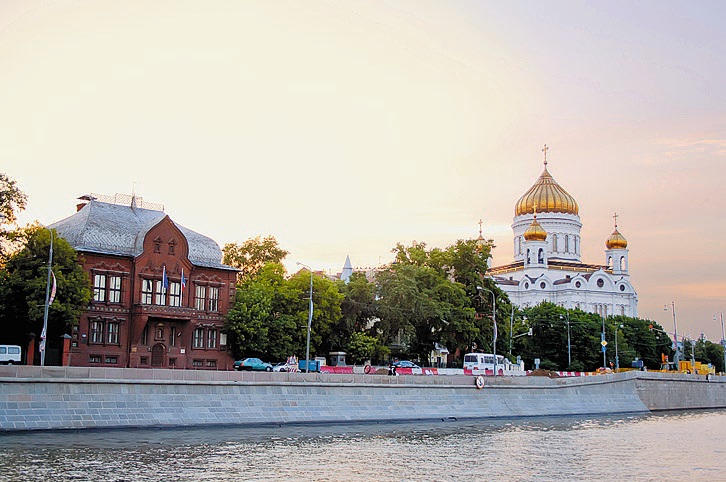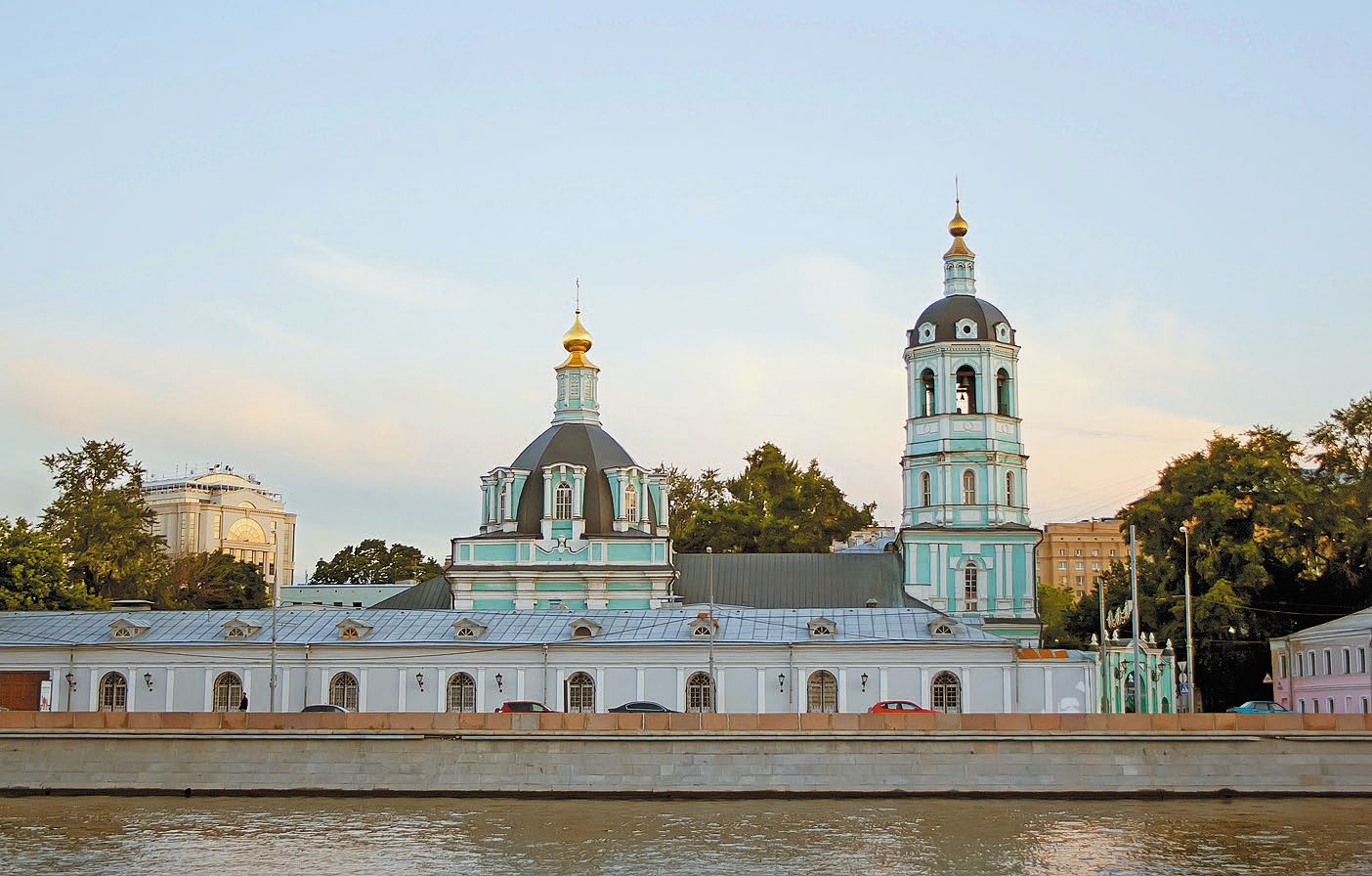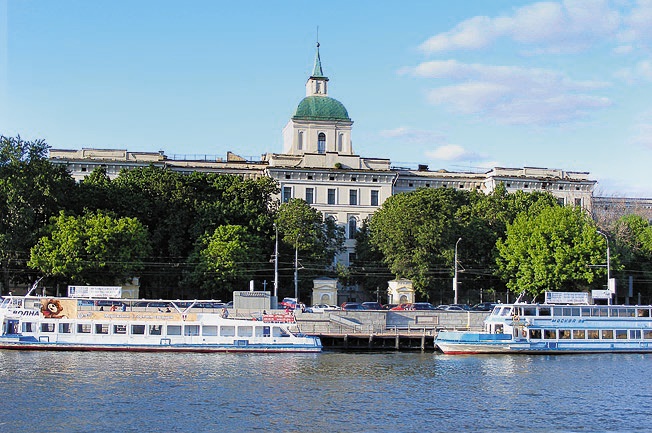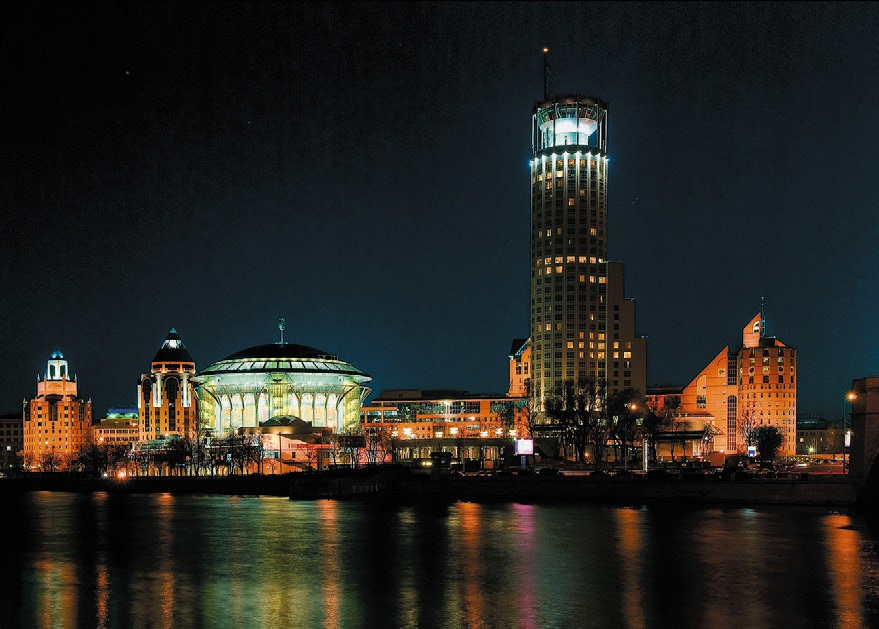Among the vast variety of river trips, we have chosen a route that allows you to see the main attractions of the capital. So, you begin your route from the “Kievsky railway station” pier. Do not forget to look around. Behind you is Borodinsky bridge, a remarkable monument to commemorate victory over Napoleon, the “White House”, or the House of the Government of Russian Federation, and one of Stalin‘s skyscrapers, the “Ukraina” hotel. To your right, there is the building of the Kievsky railway station, and in front of you, the pedestrian Bogdan Khmelnitsky bridge.

The cruiser begins to move forward, and soon you will see on your left some temples of the Novodevichy Convent. On your right, you will see another one of the skyscrapers, the building of Moscow State University. If you turn back, from this perspective some presently constructed buildings of the business center of Moscow City and the House on Mosfilmovskaya street will be visible.
The building of Moscow State University and the Luzhniki Stadium go slowly by, and here, is our first stop, the Vorobyevy Gory. A beautiful nature reserve is located here. Here, you may also see the unique Luzhnetsky metro bridge.

Ahead is a noteworthy building of the Presidium of the Russian Academy of Sciences, which is well marked by its crowning golden feature of an original design, nicknamed by locals as “golden brains.”
You pass under the bridge, and your next stop shall be Frunzenskaya embankment. On the right side, Neskuchniy garden and an approaching pier are visible.
The Central Park of Culture and Relaxation named after Gorky. It is always very lively here. If you have time, you can get off at this stop and take a walk at the newly landscaped park.

Disembarking again from this pier, you will be floating under the Pushkinsky bridge, and soon see a beautiful bright church on your right, the church of St. Nicholas in Khamovniki. It was built in the late XVII century, and represents the Russian ornamental style quite popular in Moscow. Incidentally, the area that you pass is called Khamovniki not because being inhabited by poorly educated people. In the old days, khamovniki were weavers, and this profession gave its name to the area where they settled. There are several places named after craftsmen in Moscow, such as Textilshiki, Kozhevniki, Pechatniki, etc.

Here, in front of you, is one of the most famous bridges of Moscow, –Krimsky bridge, with same name pier right in front of it. If you leave here and go across the bridge, you can visit the Central House of Artists, a branch of the State Tretyakov Gallery on Krimsky Val, and Museon Park of Arts.
Directly in front of you is one of the most criticized Moscow‘s monuments, a monument to Peter the Great. And on your left, you already see the golden dome of the Christ the Savior Cathedral. But first, do pay attention to the two buildings which will appear in front of you a little earlier.
The first house (Prechistenskaya embankment, 29), a red brick building looking like a gingerbread house, was built in 1901 to the design of the famous Russian artist V.M. Vasnetsov. During World War II, there was the headquarters of the Normandie-Niemen squadron, and now, this house is the residence of French Ambassador, as indicated by the flags of France and the European Union.

A little further, there is another building (Kursovoy side street, 1), made by mixing two seemingly not combinable architectural trends: modernism and neo-Russian style. However, the building has turned out wonderfully harmonious and very beautiful.
Majestically swims past you Christ the Savior Cathedral, or Cathedral of the Nativity. The current building was created between 1994-1997, on the site of the church demolished in 1937. The old church was erected in honor of the victory over Napoleon‘s army, and was being built for almost 44 years. Now, this is where the main celebrations worship services are held.
Vodootvodny channel moves to the right and you continue your journey on the Moskva river. The next pier, the Estrada Theater, is located behind the Patriarshy bridge.
Between two Bolshoy bridges, the Kamenny and Zamoskvoretsky, you will see a panorama of Kremlin. Ancient walls and towers, churches, glittering domes, gold-sparkling Grand Kremlin Palace, all parts of this panorama is symbolic of Moscow and Russia. Following the Moskvoretskaya corner tower, a Red Square view opens up.

Then, almost opposite to each other, are two architectural monuments. On the left is the building of the Imperial Orphanage, which was built in 1764, and reinforced and rebuilt up until 1960, and on the right is the church of St. Nicholas in Zayaitskoye. Its name has long been giving a cause for pondering to the toponymy specialists. Indeed, the fact that Ural river was formerly called Yaik is known to all, so, obviously, Zayaitsky means located across the river Yaik, which is also clear. But what is the connection between the Urals and Zamoskvorechye? The explanation is most often found in the fact that people migrated from those places came to settle here. This church was built in the years 1749- 1759 in Baroque style. Now you are floating under Bolshoy Ustinsky bridge, so note that the left side of Moskva river branches off as a lesser stream – this is Yauza. There on the left is one more “Stalin‘s” skyscraper, the house on Kotelnicheskaya embankment. At various times, there lived many famous people, including actress Faina Ranevskaya, ballerina Galina Ulanova, director Yuri Lyubimov, and many others. The cruiser makes the penultimate stop here.

On the right, you will soon see another beautiful building with columns – the building of the New Krigskomissariat (institution for the supply of the army). It was built in 1776-1780.
And on the Bolshoy Krasnokholmsky bridge, on the right, a glass building with a treble clef sign on the roof will be seen. This is Moscow International House of Music.
The last, and, for non-looping routes, the final stop of this way is called Novospassky bridge. It was named after the nearby Novospassky monastery. If you choose to see it, do not forget that there is another monument, Krutitskoe Podvorye, nearby.
